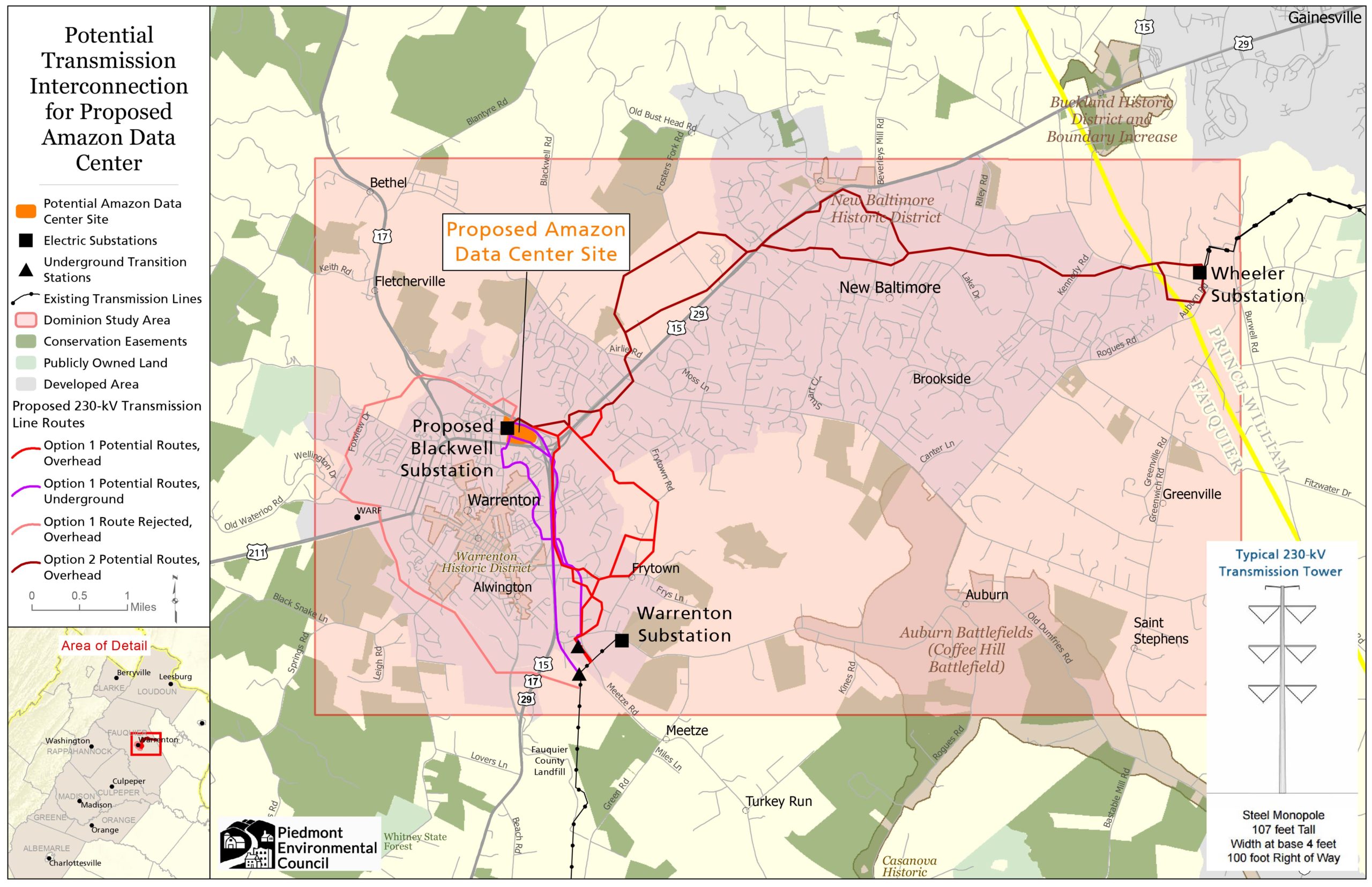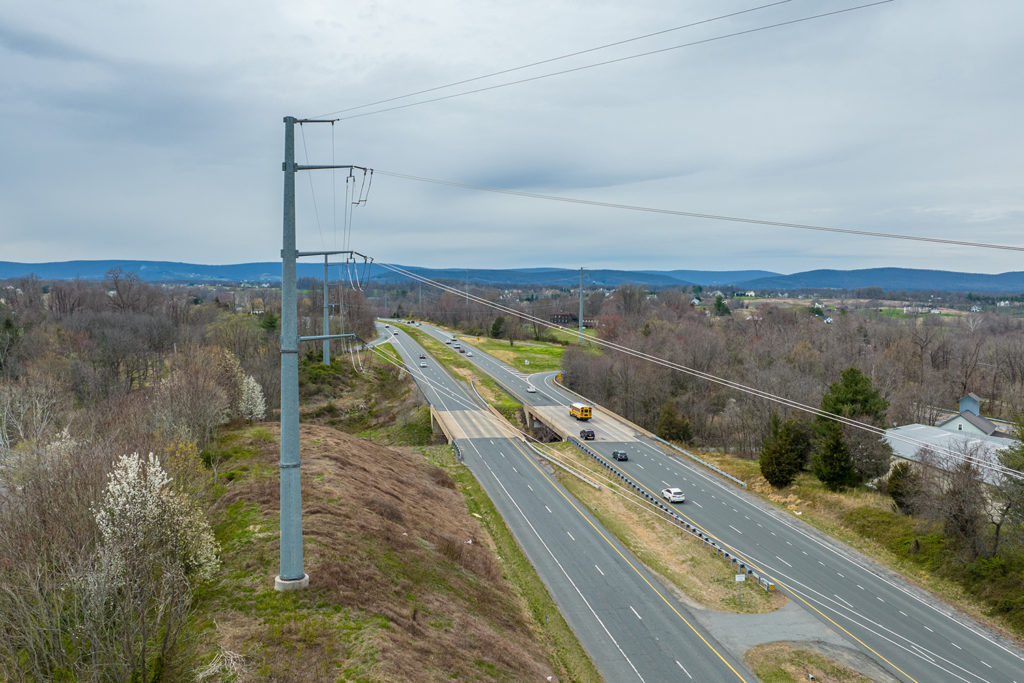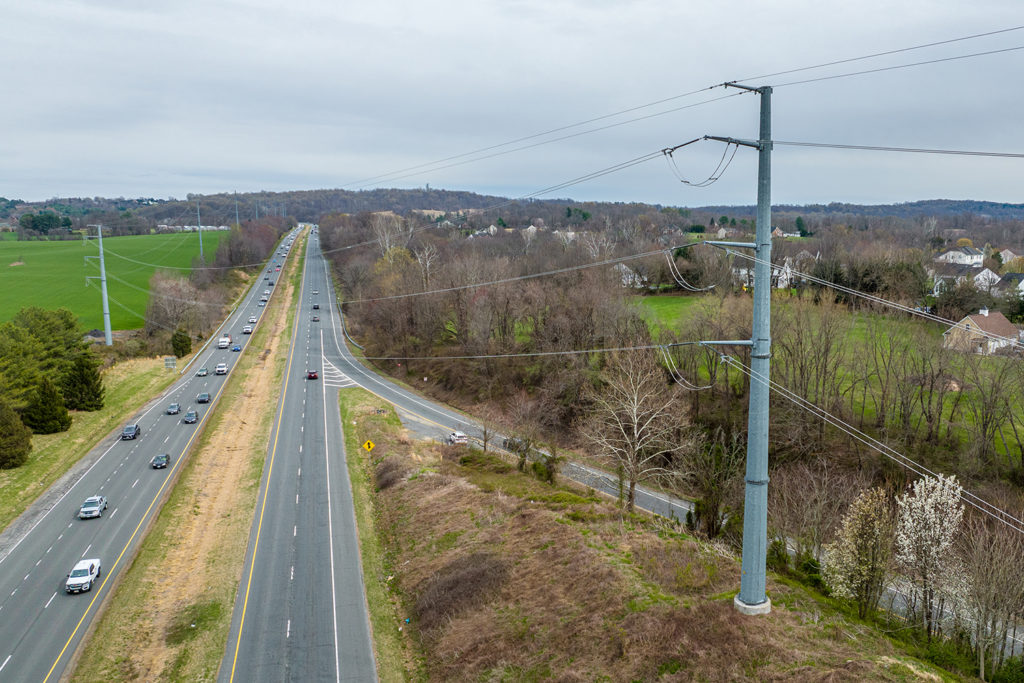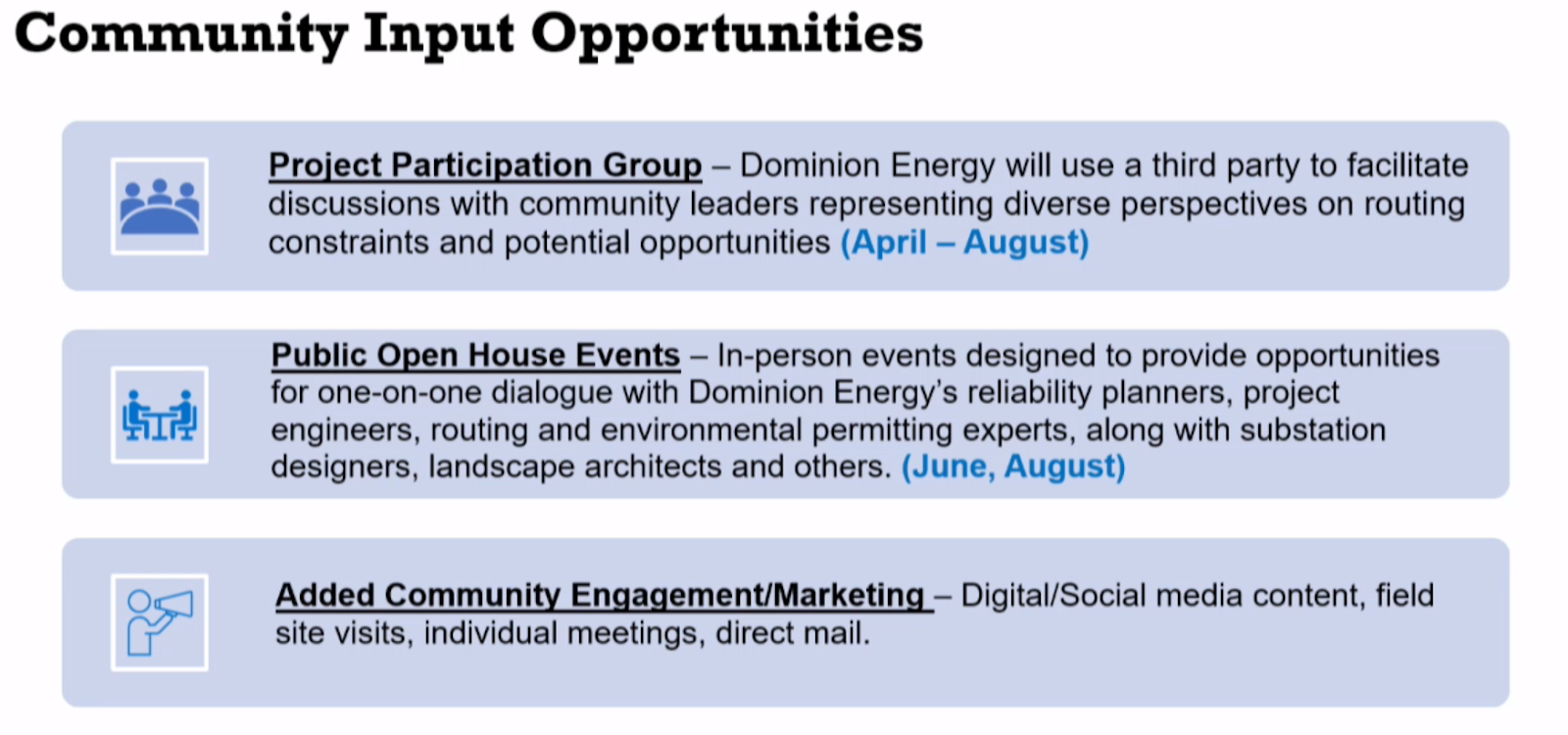Fauquier residents may have seen recent articles referencing the purchase of an in-town parcel by Amazon for construction of a data center somewhere on the 41-acre site. The property in question is located on Blackwell Road, behind Country Chevrolet (near the Sheetz and Giant) on the northeast side of Warrenton.
Shortly after the purchase, PEC Land Use Coordinator Kevin Kask wrote an op-ed pointing out a lack of details from Amazon regarding its intentions to build out the property, including questions about where they would source their power and the location of any new required infrastructure. As of the beginning of April, Amazon has not filed an application with the Town and no information about the size, scale or scope of the proposal has been shared with the community.
However, in late March consultants for Dominion Energy stopped by The Piedmont Environmental Council office in Warrenton to discuss a potential new transmission line project with us. They explained that in order to serve the proposed Amazon Data Center, Dominion expects to build a new substation at the Amazon site and then bring a new 230-kV transmission line into that substation.
To be clear, the Amazon data center is the only reason Dominion would be required to build a transmission line to the other side of Town.
During that initial conversation, Dominion’s consultants did not share any routes with us, but rather informed us that Amazon had sent a “load letter.” On April 14 though, during a Fauquier County supervisors’ work session, Dominion presented several possible routes that would link into either of the two closest substations—Warrenton (off of Meetze Rd, next to the Central Sports Complex) or Wheeler (in Prince William County near Vint Hill).
Below is a closer look at where the existing transmission lines terminate, along with Dominion’s released study area and potential route options (red lines indicate overhead transmission lines and purple lines indicate underground transmission lines) for the Amazon site:

This Tuesday, we participated in a Dominion-facilitated stakeholder meeting to learn more about the potential transmission line routes and provide feedback. The Dominion reps were very clear that the Amazon data center is the only reason the utility would be required to build a transmission line to the other side of Town. Dominion’s community input process includes stakeholder meetings running through August, with community open house events planned for the evenings of June 22 and June 23 (locations to be determined), and a plan to file an application with the State Corporation Commission by fall 2022.
Visual Impact Would Be Substantial
For scale, 230-kV transmission lines have an average height of around 110-ft tall (more than 10 stories), with variation due to topography and tower design. This is almost double the height of mature tree canopy, making them difficult to conceal.
For perspective, the photos below show a few existing 230-kV lines in Loudoun County:
What’s Next?
Dominion’s community input process includes stakeholder meetings running through August, with community open house events planned for the evenings of June 22 and June 23 (locations to be determined), and a plan to file an application with the State Corporation Commission by fall 2022. PEC plans to participate in the group discussions and share information (through our website, social media and email alert) about open houses once dates are set. Dominion anticipates submitting its application to the State Corporation Commission (SCC), which has the final say in approval of the line, in fall 2022. Project information will be posted at DominionEnergy.com/blackwellroad.
Our View
PEC has a long history with transmission line planning and siting, and we know it to be a difficult process that can pit community against community. With any transmission line project, we believe the first step is to look hard at whether the project is actually needed.
That’s where this one gets tricky. Amazon has purchased the property with the intention of building a data center there. However, an application for a special use permit to construct that data center has not yet been submitted to the Town of Warrenton. A data center is not a by-right use and must be evaluated against the Comprehensive Plan and impacts to the surrounding community. As this particular parcel is currently planned for mixed use development and located in a fairly visible location, the Town must consider the impacts of this change and carefully evaluate the design, height, and screening, along with fundamental issues such as water usage, which is often required for cooling.
Dominion has stated that the transmission line project is needed to serve the Amazon data center. However, neither the size nor scope of the Amazon facility has been submitted, let alone approved. In other words, there are two separate permitting processes—Amazon’s special use permitting process before the Town of Warrenton (which hasn’t been filed) and a transmission line permitting process that will end up before the State Corporation Commission—and they appear to be out of alignment.
We believe the two processes should be concurrent. What happens in one should impact what happens in the other. Instead, we’re about to embark on the transmission portion, absent a real proposal from Amazon.
That leaves us with a number of questions:
- What exactly is Amazon going to propose at the site? It’s hard to evaluate a project when nothing has been submitted yet. How big will it be? What is the site layout? What are the water impacts? Are they offering anything to mitigate the impacts of the project?
- The data center would require Town of Warrenton approval. What happens if the Town denies Amazon’s special use permit?If the town approves a smaller data center project, how would that impact Dominion’s proposal?
- What load projections are being used to determine the need for a 230-kV line?
- If the data center was located elsewhere, would there be a less intrusive transmission option? For instance, there is land planned and zoned for a data center in the Remington Service District next to an existing substation.
- Who pays? This would be a multi-million dollar project. Would that cost be paid for by Dominion customers alone or could Amazon be made to underwrite a portion of the project? Our understanding from Dominion is that the entire project would be rate-based, meaning paid for by Dominion customers in their monthly utility bills.
- Would the State Corporation Commission truly consider underground routes, given price is typically one of its primary considerations when making routing decisions?
Going Forward
An overhead 230-kV transmission line to Amazon’s Blackwell Rd site would have the effect of industrializing any corridor it runs through. From our initial look, all of the possible routes to the proposed Amazon site would have a detrimental impact on the gateway(s) into the Town of Warrenton, on historic and cultural resources along the route, and to the residential neighborhoods of New Baltimore, Vint Hill and/or Frytown (a historic African American community).
Rather than accept that an Amazon data center at the entrance to Town is a done deal, we hope community members will urge the Town Council to think twice about approving a data center at the proposed location and instead evaluate its full range of impacts given the additional transmission infrastructure required.
If the Town approves a data center at the Blackwell site, we hope community members will join us in insisting that it be conditioned upon the associated transmission lines being underground. Furthermore, we believe that Amazon, a company with a current market value of over $1.5 trillion and net income in 2021 of over $33 billion, rather than the ratepayers of Virginia, should bear the additional cost of the underground lines.
As for the state process, if it moves forward, local residents and groups like PEC will need to weigh in with Dominion and the State Corporation Commission to ensure the transmission line project is sized, designed and sited appropriately; that our natural, historic, and cultural resources are protected as best as possible; and that the local community is heard throughout the process.



